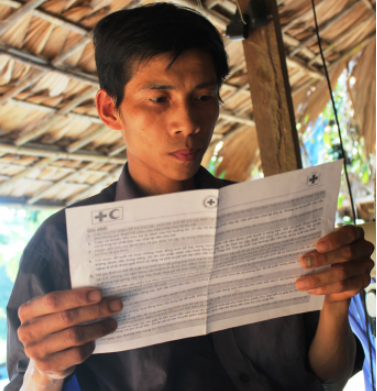November 28, 2019
British Red Cross launches new Community Engagement Hub
By La urel Selby
urel Selby
CEA Hub Content officer, British Red Cross
What is the Community Engagement Hub?
The British Red Cross, in close collaboration with the International Federation of Red Cross and Red Crescent, has launched its Community Engagement and Accountability (CEA) hub to provide tools, resources and training materials to volunteers and staff within the Red Cross Red Crescent Movement and aid workers across the sector.
The CEA hub, which has been funded by the UK’s Department for International Development, is a free online platform with over 300 resources, providing a ‘one stop shop’ for anyone mainstreaming community engagement and accountability. Materials range from a ready-to-download three-day training package, to a toolkit designed to help set up and manage complaint and feedback mechanisms in any context.
Community engagement and accountability is a core approach within the Movement, that puts people at the centre, promoting a two-way communication to provide timely and relevant information to communities, while allowing them to participate in decision-making processes.
Sophie Everest, British Red Cross community engagement and accountability adviser, said:
“Aid operations only work when we work with people. When we engage, we learn, and we create a better response for people in need. We are seeing the difference this work makes right now during the Ebola outbreak in Democratic Republic of Congo. By listening and acting on community feedback, the Red Cross has been able to gain acceptance and access in more areas. Over 880 volunteers have gone door-to-door to exchange information and address concerns.”
Cash Assistance and CEA:
The Red Cross and Red Crescent Movement often uses humanitarian cash assistance to help people affected by a crisis. It is essential that we apply participatory approaches when carrying out this work, to make sure that we meet people’s needs and deliver cash according to the preferences of the communities we work with.
Sophie Everest, British Red Cross community engagement and accountability adviser, said: “Cash transfers can be a better way to help people, even in some of the most complicated contexts, and are often more cost-effective for humanitarian agencies. The engagement of affected communities in decision making processes related to cash is integral to ensuring we are distributing cash in the right way to the right people. Not doing this can spread misinformation and rumours, and can create or exacerbate tensions within communities. This can cause harm and runs the risk of undermining the reputation of the Red Cross and Red Crescent Movement and the trust we have built over many years with the people we serve.”
To support volunteers and staff within the Red Cross Red Crescent Movement incorporate community engagement and accountability into their cash activities, the CEA Hub hosts a page dedicated to the incorporation of CEA into cash programmes. This section includes case studies, research and guidance which can help to understand people’s experiences during and after emergencies in the context of cash operations.
Cash and CEA in action:
Community engagement and accountability has been integrated into cash programmes across the globe, from cash transfer programmes put into place after the April 16 earthquake in Ecuador, to cash assistance rolled out after the 2013 Typhoons in Viet Nam.
Within the first two weeks of October 2013, central provinces of Viet Nam were hit by two consecutive typhoons, Typhoons Wutip and Nari, resulting in 31 deaths and 330 injuries. The total economic loss was estimated at USD 734 million. In response to the disaster, the IFRC launched an emergency appeal for a period of 12 months, covering activities from relief, shelter, health, water and sanitation, livelihoods to disaster preparedness. Cash transfer was an integral part of the operation.
The engagement of affected communities in decision making processes related to cash grants was an integral part of the Typhoon Wutip and Nari operation. After developing selection criteria and guidelines for allocating grants, the Viet Nam Red Cross Society shared the criteria via local media and public notices. Community members were then invited to participate in village meetings to nominate beneficiaries. Following the meetings, the lists of beneficiaries were publicized on local loud speakers for three days and in public places for five days to allow for feedback from the community. With support from the IFRC, the Viet Nam Red Cross Society developed posters displaying the objectives of the cash transfer programme, the cash grant values, beneficiary selection criteria and selection process, and the hotline phone numbers in case of any questions or concerns.
When Typhoon Nari hit, the house of Tran Van Hieu, a resident of the Huong Giang commune, was inundated with flood water. His home was left completely unroofed and his family’s foodstock lost. Hieu’s family was one of the households which received a cash grant from the Viet Nam Red Cross Society, and which used the hotline phone number. With the cash grant, his family discussed and decided to invest in a cage and two pigs. This was the first time his family had enough cash in-hand for them to buy pigs. Along with cash distribution, the Red Cross also supported his family and others to complete a livestock development plan, raised their awareness about livestock related diseases and provided them with prevention as well as curative methods. After a year, his pigs already gave birth once, helping his family to recover the investment rel=”noopener noreferrer” and continue to invest.

